Maple trees are among the most popular trees in North America especially due to their beautiful shade, fall color and large number of flowers they produce during springtime.
According to Utah State University, there are over 300 types of maple trees ranging from small to large varieties and growing from the oceans to the prairies. Although all maples have similar characteristics, there are differences in leaf shape and size, the location where they grow, their growth patterns and so on.
This group of trees includes types that are useful in several ways either as large shade trees, as medium-size specimen trees or as smaller, shrubby ornamental trees.
Characteristics of Maple Trees
- Most maple trees are native to Eastern North America, Asia, Central Europe.
- They grow in either full rounded or upright form with small or spreading canopy.
- Most have a stunning fall display that range from red, purple, orange, yellow and pink in color.
- They consist of bud which open in the spring and flush out flowers and later dangling winged fruit called samaras that are as attractive as the flowers.
- Many maples are fast growing in nature. They grow about 36 inches each year and can grow up to 120 feet tall, though they average about 40 to 60 feet.
- When mature and given room to spread, a number of maples make excellent shade trees
- Most maples have weak branches that are more susceptible to breakage from ice storms or high winds.
- The trees in general have opposite, palmately lobed simple or compound leaves.
- The leafstalks are long and slender whereas the blades are palmately veined, meaning each has several main veins, all extending from the same point.
- All maple trees are deciduous, losing their leaves in winter and growing new foliage the following spring.
- Maple blossoms may be green, yellow, orange or red and usually grow in clusters of five.
- Generally, maples are quite tolerant of most garden conditions, growing well in full sun or partial shade.
- Maple tree bark changes as the tree matures. From flawless-smooth, light brown to gray bark that develop cracks and fissures.
- Maples also feature light-colored straight-grained wood.
- As with most trees, forest-grown maple trees form a much taller trunk and narrower canopy than open-grown ones.
List of Maple Trees
- Silver Maple
- Sugar Maple
- Sycamore Maple
- Tatarian Maple
- Vine Leaf Maple
- Red Maple
- Paperbark Maple
- Norway Maple
- Japanese Maple
- Hornbeam Maple
- Hedge Maple
- Big Leaf Maple
- Amur Maple
- Boxelder Maple
- Striped Maple
- Trident Maple
- Mountain Maple
- Three-Flowered Maple
- Coral Bark Maple
- Black Maple
- Douglas Maple
- Snakebark Maple
- Shantug Maple
- Chalkbark Maple
- Rocky Mountain Maple
Facts About Different Maple Trees
Silver Maple
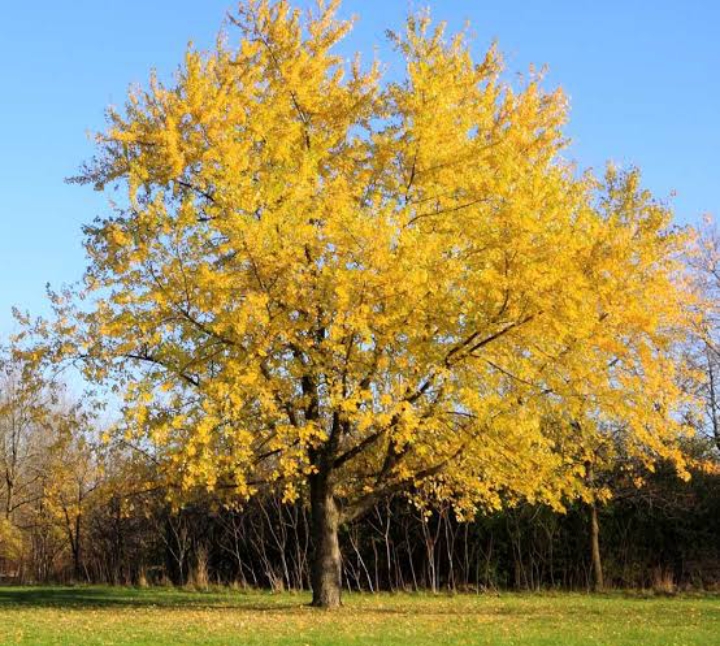
- Scientific Name: Acer saccharinum
- Height: 50 to 100 feet
- Fall Color: Yellow
- Native Area: United States and Canada
The silver maple is native to the eastern and central United States and southeastern Canada. It is one of the most common trees in the United States.
It can grow up to 120 feet tall with spreading branches. The spreading branches make the tree’s crown to appear rounded.
The leaves of the silver maple are green on top and a silvery-white beneath, which is why they are called silver maples. Given a gentle breeze, the silvery of the leaves shimmer in sunlight creating a beautiful effect.
Fall color of this maple ranges from greenish-yellow to brown-yellow. As the maple matures, their thin smooth silvery bark thickens and begin to shed in strips revealing reddish brown bark.
Their roots grow aggressively, often affecting the underground soil. Silver maple is known to grow in floodplains, along streams and rivers. [Source: University of Minnesota]
Also Read: Types of Eucalyptus Trees In North America
Sugar Maple

- Scientific Name: Acer saccharum
- Height: 50 to 80 feet
- Fall Color: Red to yellow to orange
The Sugar maple tree is one of the most common trees in New York and its been named the state tree. It is also the main feature on the Canadian flag.
This tree has a distinctive shape and grow up to 80 tall with a dense rounded crown when mature. In the fall, its palmate leaves put on a beautiful show, turning several colors from red to yellow to orange.
The bark of younger trees is grayish-brown in color which deepens to dark-brown when the tree matures.
It is an excellent shed tree and can live more than 150 years in the right environment. The sugar maple tree gets its name from its sweet sap, which is used by boiling to make maple syrup. [Source: University of Kentucky]
Sycamore Maple
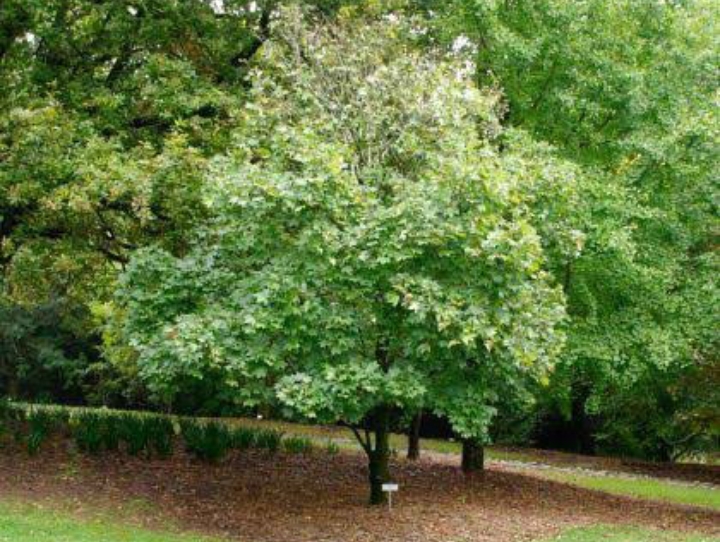
- Scientific Name: Acer pseudoplatanus
- Height: 50 to 115 feet
- Fall Color: Gold-yellow to red
Sycamore maple tree is among the most common in North America and grows in almost every part of United States.
This is generally a large maple growing up to 115 feet tall with arching branches and broad bases, forming a more columnar shape than other maples. The bark is grey when young and later turns dark-brown, flaking in irregular patches as it ages.
The leaves have a leathery texture with visibly thick veins on the underside. Some cultivars have yellowish or purple leaves. In autumn, the leaves turn from gold-yellow to red.
Tatarian Maple

- Scientific Name: Acer tataricum
- Other Name: Tatar maple
- Size: 12 and 35 feet
- Fall color: Yellow and red
Tatarian maple is a maple tree that has been in existence for several centuries. The first Tartarian maple tree is said to have been planted in the 1820 along the Volga River in Tatarstan region of Russia.
Tatarian maples are common in the forests of the Pacific Northwest, Southeastern Europe and temperate Asia.
Tatarian maples are generally small growing trees or spreading shrubs. They grow between 12 and 35 feet tall with short trunks and slander branches resulting in a rounded canopy.
The bark is thin dark-brown in color and eventually becoming pale-brown with shallow fissures as the tree ages. During the growing season their leaves are green but eventually turning yellow in early fall and red in late fall. [Source: Minnesota Department of Agriculture]
Vine Leaf Maple

- Scientific Name: Acer circinatum
- Other Name: Tatar maple
- Size: 10 and 35 feet
- Fall color: Golden yellow and red
The vine leaf maple tree grows in United States, from Southwest British Columbia to Northern California and the east side of the Cascade Range.
This maple is a large shrub or small tree, growing between 12 and 35 feet with a trunk diameter of not more than 10 inches. It often develops multi-trunks with reddish-green bark.
This tree boasts a beautiful foliage that begin in a red hue during spring and then takes on red and golden tones during autumn.
Vine leaf maple is actually the only maple with layering ability because it bends over easily making the top of the tree to touch the ground and consequently begin to send out new root system.
Red Maple

- Scientific Name: Acer rubrum
- Other Name: Soft maple, Swamp maple, Scarlet maple, Carolina red
- Size: 55 and 120 feet tall
- Fall color: Brilliant red but can also be yellow or orange in some varieties
According to U.S Department of Agriculture, Red maple is the most abundant maple variety in North America naturally growing in places as diverse as Quebec, Manitoba, Ontario, Florida, Minnesota and Texas.
All red maple varieties can survive in environments ranging from wetlands, prairies, misty woodlands to dry, rocky hills and mountains.
In the environment with the right conditions, red maple can grow up 120 feet tall with somewhat oval or conical shaped crown, though most varies stay between 40 and 60 feet tall.
Early in the season, the leaves begin to turn yellow and red then to bright scarlet and crimson in the autumn. The bark of this trees is always pale gray becoming darker and fissured into raised long plates as the trees age.
Paperbark Maple
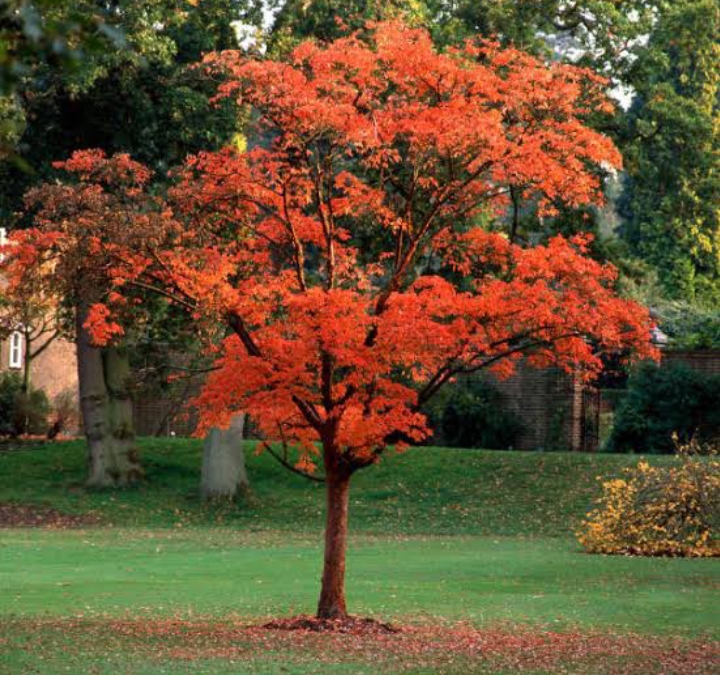
- Scientific Name: Acer griseum
- Other Name: Blood-bark maple
- Size: 20 and 40 feet tall
- Fall color: Brilliant red
Paperbark maple is native to central China, but can be found in many places in Europe and North America growing near wet areas as well as dry woodlands near streams and rivers.
It grows in U.S states including Indiana, Michigan, Minnesota, Ohio, Pennsylvania and Wisconsin. Its name comes from its cinnamon-colored bark, which peels in large sheets that remain on the tree and give an interesting effect.
Paperbark maple is among the best garden trees because they grow fast enough to establish themselves quickly after planting yet they require little care once establish. This tree can reach heights of between 20 and 40 feet tall.
It also feature a lush foliage which turns brilliant red in autumn. The young trees of this maple variety, have smooth orange-red bark that peels in thin papery layers and becomes rough and wrinkled as they mature.
Also Read: Different Types of Pine Trees
Norway Maple
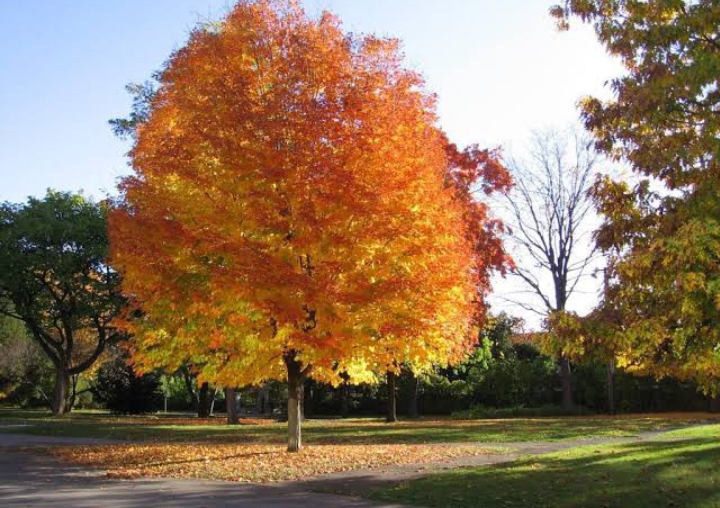
- Scientific Name: Acer platanoides
- Size: 40 and 60 feet tall
- Fall color: Usually yellow, occasionally orange-red
Norway maple is native to Southern Scandinavia, central Europe and western Asia. It is widely planted as shade tree in many urban areas in Europe, Asia and North America.
Norway maple is a large maple variety usually growing approximately 40 and 60 feet tall but can grow up to 90 feet or more in the right environment. It has a lifespan of approximately 70 years but it can live more than 100 years.
Young bark is olive to light brown and becomes gray and shallowly furrowed with age. Unlike other varieties of maple such as paperbark or big leaf, mature trees do not develop a deeply furrowed or fissured bark.
This tree’s fall color is often yellow, occasionally orange-yellow. It also produces a large quantity of viable seeds.
Japanese Maple

- Scientific Name: Acer palmatum
- Other Name: Palmate maple or smooth Japanese maple
- Size: 40 and 60 feet tall
- Fall color: Shades of red, orange, yellow or purple
- Native Area: Japan, Korea, Mongolia
Japanese maples are the most popular type of maple tree all over the world. They are native to Japan, but have been introduced to North America and Europe. They are commonly found in parks, home gardens and along streets in urban areas.
With a variety of cultivars, Japanese maple tree size varies greatly. Some varieties are better described as shrubs although even a tall Japanese maple is considered a small tree. They may have multiple trunks joining close to the ground.
These trees always have a unique (upright or weeping) shape and can grow between 10 and 25 feet tall with trunks of up to 12 inches in diameter. In the wild, they can grow to 40 feet or more, though such heights are rare in cultivation.
They feature branches that arch outward and make it look like a living umbrella. They are also highly decorative, versatile species and grows well in any climate from cold winters to hot summers.
The bark is smooth and gray-brown in color, but will turn red or yellow as it ages. The leaves turn red, orange and yellow or purple before falling to the ground in the fall.
Also Read: Japanese Trees
Hornbeam Maple

- Scientific Name: Acer carpinifolium
- Size: 15 and 30 feet tall
- Fall color: Brilliant yellow
- Native Area: Japan
Hornbeam maple is native to Japan and its surrounding islands. In North America and Europe, this maple grows often in woodlands and alongside streams in mountainous or hilly areas. The maple is also common in home landscapes and urban settings.
Hornbeam maple is a small tree that can grow up to 30 feet tall with a broad crown. This maple works best as a shade tree because it has few branches and many leaves on each branch.
The leaves of this maple resemble those of hornbeams trees, they are dark green on top and lighter below when young, but turn yellow before falling in autumn. The tree’s bark is gray-brown, smooth when the tree is young but lightly furrowed at maturity.
Hedge Maple
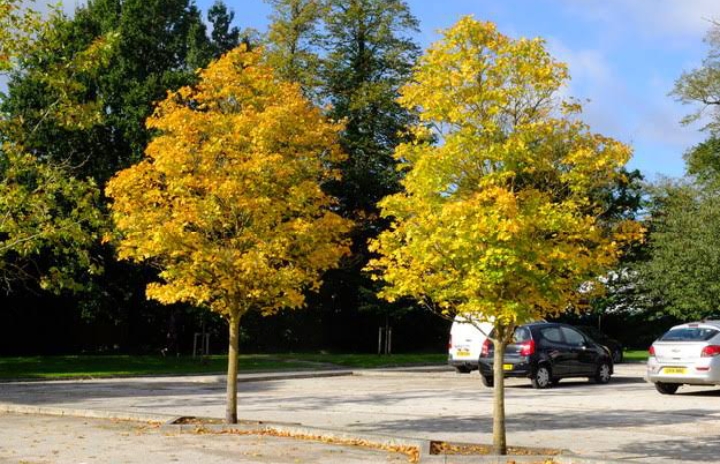
- Scientific Name: Acer campestre
- Size: 15 and 85 feet tall
- Fall color: Brilliant yellow
- Native Area: Europe and Asia
Hedge maples are natives of continental Europe and Asia but commonly found in Australia and North America specifically eastern United States with a distribution that extends to southern Canada.
They are fast growing species growing up to 85 feet tall with thick trunks and branches. They live between 100 and 200 years, but when grown in a good environment they can reach 250 years.
The maple also features brown shoots, with dark brown winter buds. The leaves turn bright yellow in fall before dropping off. The fall color display is not consistent as other maple species.
The Hedge maple’s bark is smooth and gray-brown in color, but will turn dark-gray and shallowly fissured as it ages. Hedge maples don’t require rich soils to thrive, they’ll perform well even in poor soil or rocky areas.
Big Leaf Maple
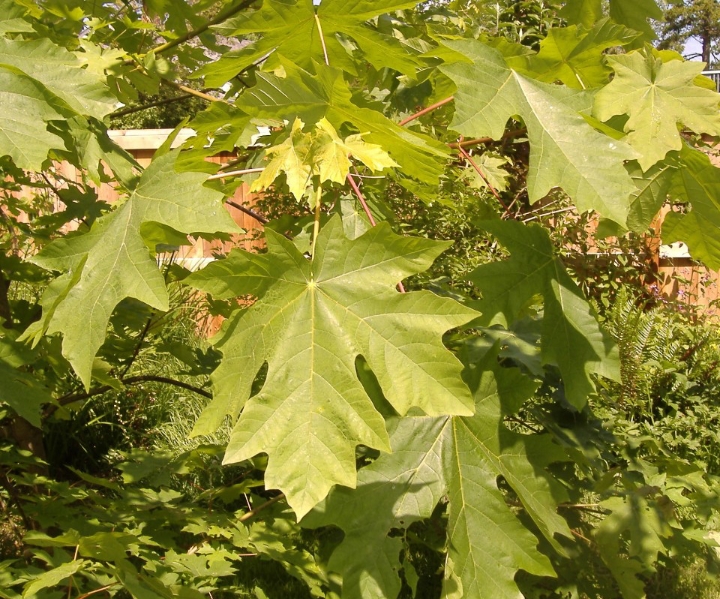
- Scientific Name: Acer macrophyllum
- Other Names: Oregon Maple
- Size: 50 and 120 feet tall
- Fall color: Brilliant yellow
- Native Area: North America
The big leaf maple is native to Western North America and can be found growing in forests, bogs, woodlands and home gardens.
In United states these leafy giants grow to the coast between British Columbia and the Bay Area of California, in Southern Alaska and Idaho.
The big leaf maple can grow up to 150 feet though most of them stay between 50 and 60 feet. The trunk is usually straight, with a broad crown having spreading limbs. This maple tree has the largest leaves than any other species of maple.
The bark of this trees is gray brown, darkening and developing ridges with age. In autumn the leaves turn golden and brilliant yellow before falling and creating a carpet of large brown leaves.
Big leaf maples can be used for landscaping purposes as they provide privacy and beauty to any landscape.
Also Read: Types of Avocados In North America
Amur Maple
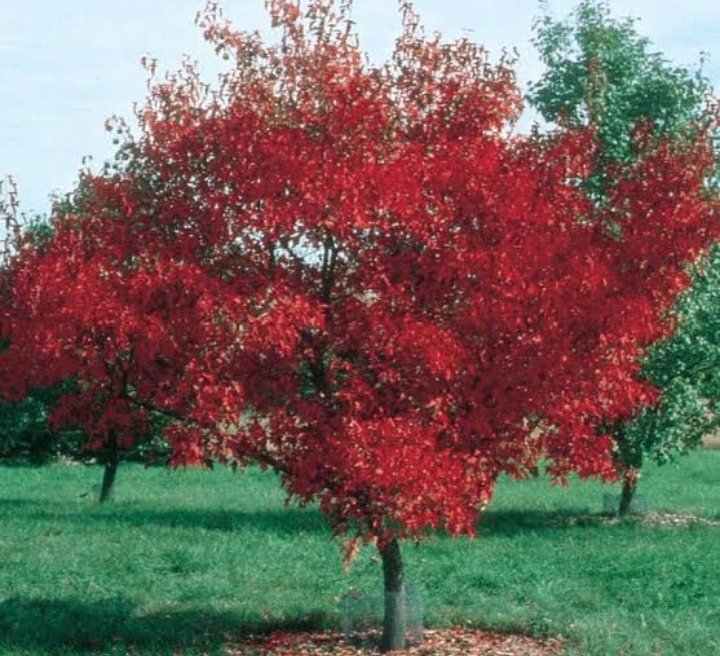
- Scientific Name: Acer ginnala
- Size: 50 and 60 feet tall
- Fall color: Yellow
- Native Area: Asia
Amur maple is a unique type of maple that produces edible seeds and nuts. It is named after its native habitat in the Russian far East- the Amur River Valley- where it grows in damp areas with poor soils.
The maple is also found in China, Korea and Japan where it is called kasumi-tsukuri. In this places, it has been used for centuries for food, medicine and other purposes.
Amur maple has been introduced in many places around the world including Europe, Northern America and Australia. In Japan it is one among the most planted ornamental trees in parks, streets and gardens. The leaves are slender and turn brilliant orange to red in autumn.
This maple tree is generally small in size reaching up to 35 feet tall with a trunk diameter of up to 36 inches. The bark is thin, dull gray-brown and smooth at first but eventually becoming shallowly fissured on old plants.
Boxelder Maple
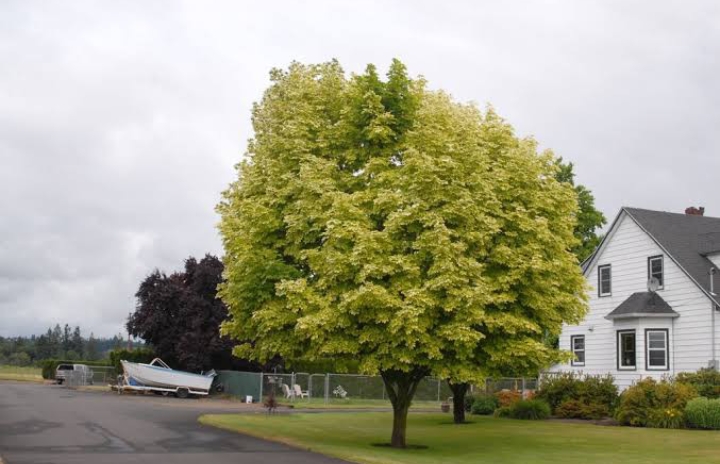
- Scientific Name: Acer negundo
- Other Names: California boxelder, Manitoba maple and western boxelder.
- Size: 50 and 60 feet tall
- Fall color: Yellow
- Native Area: North America
The Boxelder Maple, also known as Acer negundo, is native to North America. It is commonly found in the eastern and central regions of the continent, from Canada down to Mexico. The tree is often referred to as the “box elder” or “ash-leaved maple” due to its similar appearance to ash trees.
Other common names of the deciduous trees include California boxelder, Manitoba maple and western boxelder.
A distinguishing trait of boxelders from other maples is the presence of divided leaves. The trees grow fast and live from 75 to 90 years. The height of boxelders ranges from medium to tall. Some trees grow to over 50 feet in height.
The trees’ characteristics include light gray to brown bark, low branches, compound leaves and yellow-green flowers. The trees’ fruit grow as winged samares, a v-shaped, flattened, papery structure with the wings.
Branches tend to grow crooked and uneven while the trunk sometimes spreads near the ground into crooked limbs. In the fall, the leaves turn yellow and occasionally orange, but are not as vibrant as other maple trees. [Source: Nebraska Forest Service]
Striped Maple
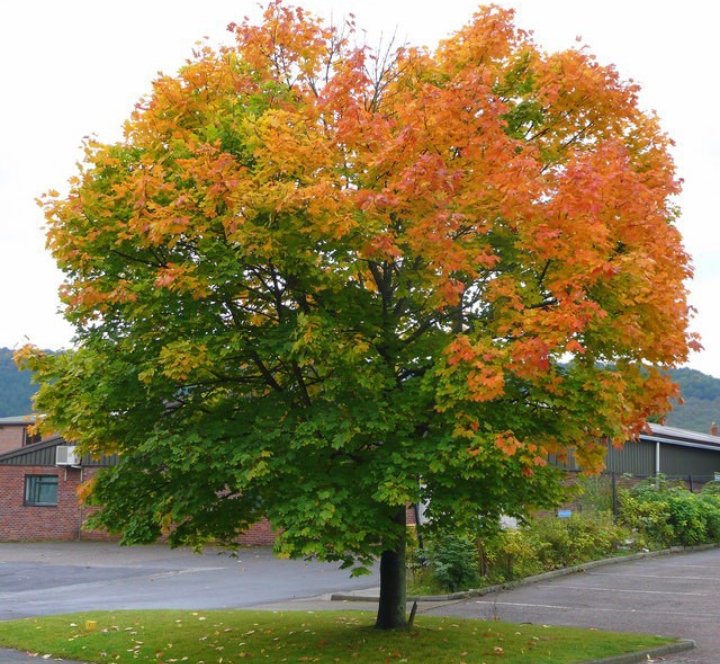
- Scientific Name: Acer pensylvanicum
- Other Names: Moosewood, moose maple or goosefoot maple
- Size: 30 to 40 feet tall
- Bark: Striped
- Fall color: Yellow
- Native Area: North America
Striped Maple is native to eastern North America. It grows up to 30 feet tall, with a straight trunk and a rounded crown. It is also known as Moosewood – a reference to the fact that the bark is consumed by moose in winter.
The leaves are green in the summer and turn yellow or orange in the fall. The tree produces small, greenish-yellow flowers in the spring, followed by winged samaras.
The trunk is generally short and forked, usually divided into a few ascending, arching branches. The bark is smooth and green or greenish brown. It features long white or pale vertical lines. As the tree matures, the bark turns reddish-brown with dark vertical lines.
Also Read: Sycamore Tree Facts
Trident Maple
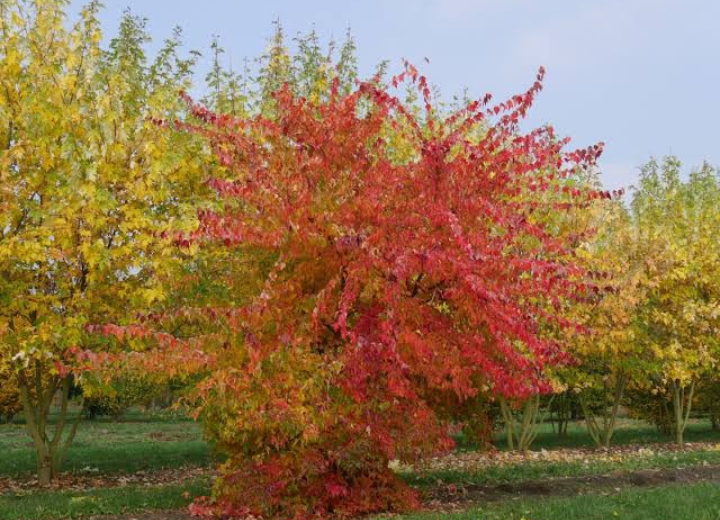
- Scientific Name: Acer buergerianum
- Size: 30 to 40 feet tall
- Fall color: Yellow
- Native Area: China, Japan and Korea
Trident Maple is native to China, Japan and Korea. The maple grows to a height of 20 to 30 feet. It has a rounded, spreading canopy with dense foliage that forms a natural shape.
The leaves are dark green in color, with three lobes that are deeply cut, giving the tree its name. The leaves turn shades of yellow, orange, and red in the fall. The bark of this maple is grayish-brown. With time it exfoliates becoming quite striking as the tree ages, showing gray, orange and brown colors.
The tree produces small, yellow-green flowers in the spring, followed by samaras. Trident Maple can be propagated by seeds, but it is more commonly propagated by cuttings or grafting. This maple is good for bonsai cultivation.
Mountain maple
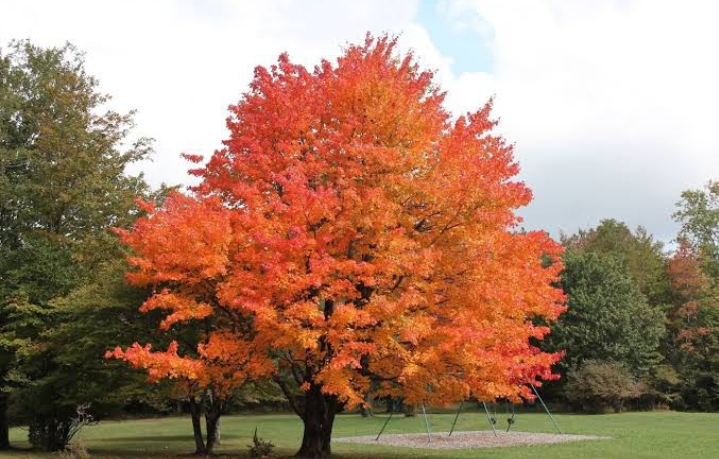
- Scientific Name: Acer spicatum
- Size: 20 to 30 feet tall
- Fall color: Yellow
- Native Area: North America
Mountain maple is native to North America. Other common names for Mountain Maple include Low Maple, Water Maple, and Eastern Mountain Maple.
The tree grows 20 to 30 feet tall, but can occasionally reach 50 feet. It has a short trunk with a spreading crown and slender, flexible branches that tend to droop.
Mountain maple is found in the eastern and central parts of North America, from Manitoba and Quebec in Canada, south to Georgia and Alabama in the United States. It is most commonly found in the understory of mixed hardwood forests.
The leaves emerge in the spring with a reddish color, turn green in the summer, and change to yellow, orange, or red in the fall. The flowers are greenish-white to yellow. They appear after the leaves are fully developed.
The Mountain Maple is a cold-hardy tree that grows in a variety of soils, including rocky, acidic, and moist soils. Its wood is light, close-grained, and hard.
Three-Flowered Maple
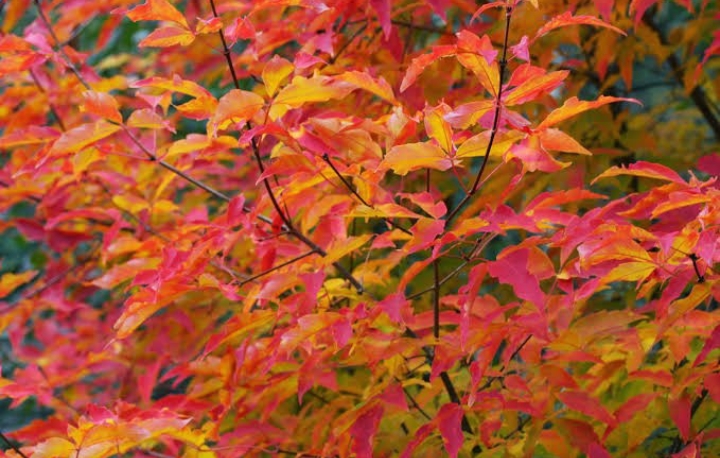
- Scientific Name: Acer triflorum
- Size: 20 to 30 feet tall
- Fall color: Yellow
- Native Area: Northeastern China and Korea
Acer triflorum, the three-flowered maple, is native to hills of northeastern China and Korea. It was first described in 1901 and introduced into cultivation in 1923. This maple is named three-flowered maple in reference to its flowers that are produced in clusters of three.
The tree can grow up to 30 feet in height. Trees are upright and spreading with a dense, delicately branched crown. Its leaves are small and three-lobed, with a glossy green surface that turns a beautiful reddish-orange in the fall.
Its exfoliating bark, which peels away in thin, vertical strips to reveal a smooth, cinnamon-colored surface beneath. The bark is especially striking in the winter months when the tree is leafless and the peeling bark is fully exposed.
The tree produces yellow-green flowers in early spring, which give way to clusters of small, winged samaras.
Also Read: Major Palm Trees That Grow Well In South Carolina
Coral Bark Maple

- Scientific Name: Acer palmatum ‘Sango-kaku
- Size: 15 to 20 feet tall
- Fall color: Orange-yellow
- Native Area: Japan
Coral Bark Maple, scientifically known as Acer palmatum ‘Sango-kaku,’ is native to Japan. It is a slow-growing tree that can reach a height of up to 20 feet at maturity. It has an upright, vase-shaped habit and a rounded crown.
This maple is referred to as Coral bark because of the distinctive coral-red color of its bark. The young branches and twigs of the tree have a bright coral-red color that stands out even in a winter landscape when the tree is dormant.
The color of the bark is most intense during the winter months when the tree is not growing, but it can also be seen in the spring and summer when the bark is exposed to sunlight.
In spring, the new foliage emerges in shades of light green, gradually turning into a vibrant yellow in the fall. This maple is hardy in USDA zones 5-8.
Black Maple
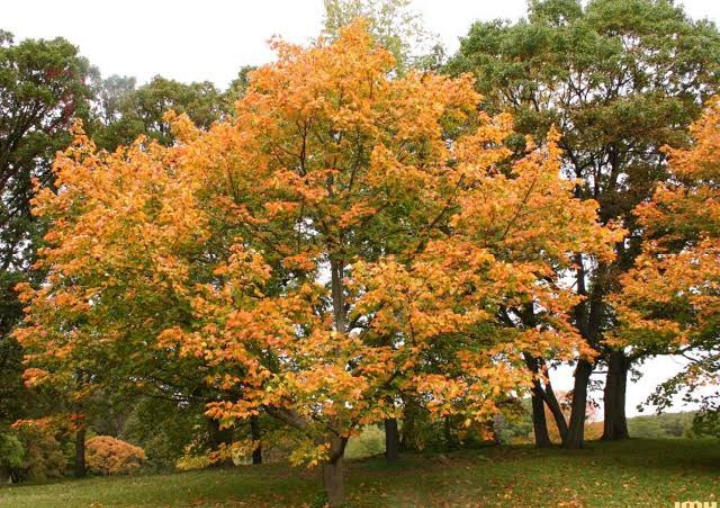
- Scientific Name: Acer nigrum
- Size: 20 to 60 feet tall
- Fall color: Yellow, red and orange
- Native Area: United States and Canada
Black Maple, also known as Acer nigrum is native to the eastern regions of North America. It is commonly found in the United States and Canada, where it thrives in wetlands, riverbanks, and upland forests.
The Black Maple is closely related to the Sugar Maple, and the two species are often confused due to their similar appearance. However, the Black Maple has darker and slightly thicker bark, with a rougher texture.
Its leaves are similar in shape to the Sugar Maple’s, but they tend to be more deeply cut and have a darker green color.
Black Maple trees grow to be about 60 feet tall with a rounded crown and a dense, spreading root system.
In autumn, the leaves of the tree can turn various shades of yellow, orange or red. The intensity of the color can vary based on the growing environment with trees growing in full sun producing the brightest and most vibrant colors. [Source: IOWA State University].
Douglas Maple
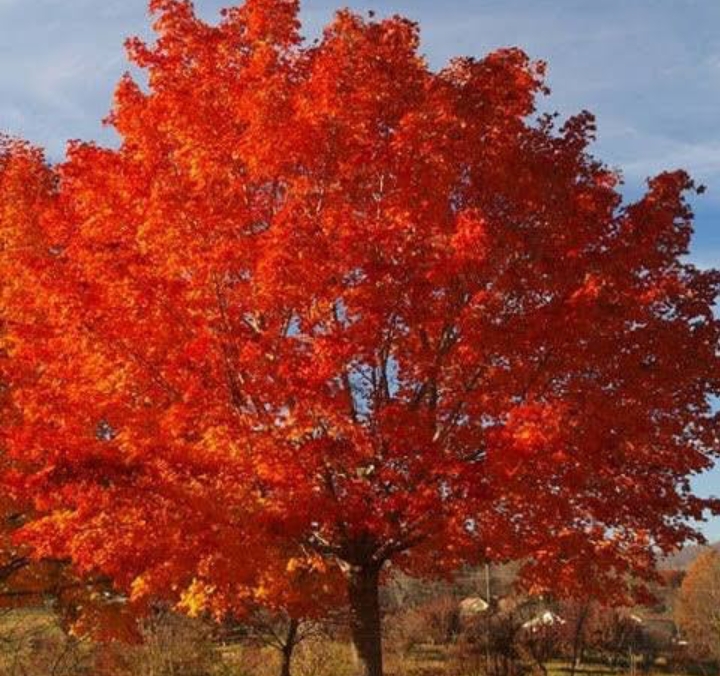
- Scientific Name: Acer glabrum douglasii
- Size: 20 to 30 feet tall
- Fall color: Yellow, red and orange
- Native Area: United States and Canada
Douglas Maple, also known as Acer glabrum douglasii or Douglas Mountain Maple, is a deciduous tree that is native to native to western North America, from southeastern Alaska, British Columbia and western Alberta, east to western Nebraska, and south through Washington.
The tree can grow up to 30 feet tall and has a spreading crown with a rounded shape. It is a hardy tree that tolerate drought once established. It is also tolerant of cold temperatures and can survive in USDA hardiness zones 4-8.
In the summer, the leaves are a vibrant green color. In the fall, they turn yellow or red before dropping from the tree. In North America It is commonly used in landscaping as a specimen tree and sometimes planted as a street tree or in parks.
Also Read: Types of Tree Species In Hawaii
Snakebark maple
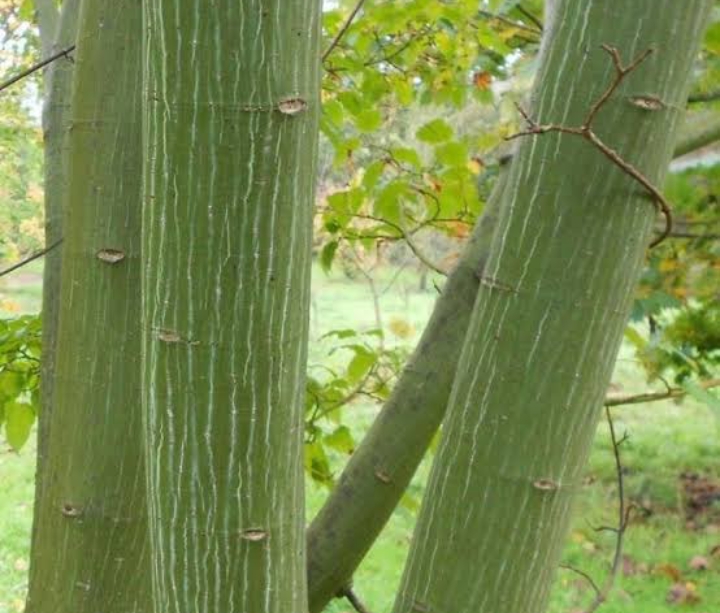
- Scientific Name: Acer davidii
- Size: 20 to 55 feet tall
- Fall color: Yellow, red and orange
- Native Area: Central China
Snakebark maple (Acer davidii) is native to central China. It is sometimes also called the David’s maple or Père David’s maple. The tree’s bark is marked with green stripes that resemble a snake’s skin, hence its common name.
This maple grows to a height of about 50 feet at maturity. It has a rounded, spreading crown and a single, straight trunk. The leaves turn a beautiful golden-yellow in the fall before dropping.
The bark is smooth and gray when young, but as the tree ages, it develops distinctive green stripes that run vertically up the trunk and branches. These stripes start out green but gradually turn gray-brown as the tree matures.
The tree is slow-growing in nature and can live for 100 years or more. The wood of the snakebark maple is hard and fine-grained and is sometimes used for furniture and other small woodcrafts.
Shantung maple
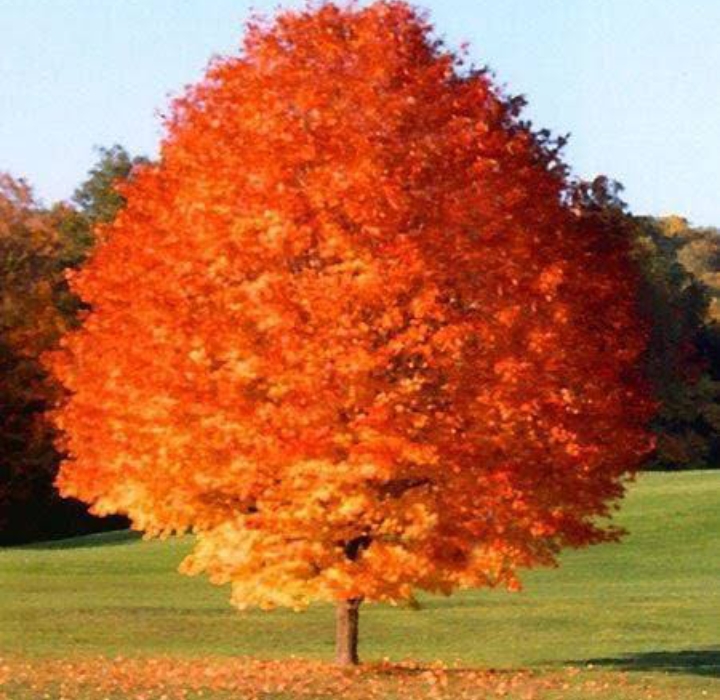
- Scientific Name: Acer truncatum
- Size: 20 to 30 feet tall
- Fall color: Yellow, red and orange
- Native Area: Japan
The shantung maple (Acer truncatum) also referred to as Shandong maple, or purpleblow maple, is native to northern China. It between 20 or 30 feet and spreading to about 20 feet at maturity. The tree also features a densely branched, rounded crown.
The tree’s leaves emerge as a purplish maroon in the early spring before turning a dark green through the summer before bursting into their autumn brilliance of yellows, oranges, reds and purples. This specimen is cold-hardy and grows in USDA zones 4 through 8.
Chalkbark Maple

- Scientific Name: Acer leucoderme
- Size: 15 to 30 feet tall
- Fall color: Yellow, red and orange
- Native Area: United States
Chalkbark Maple, scientifically known as Acer leucoderme, is native to the southeastern United States, primarily in the states of Georgia and Alabama, and is commonly found growing in mixed hardwood forests, along stream banks, and in other moist habitats.
This is a medium-sized tree growing between 15 to 30 feet in height. The tree has a rounded crown, and its bark is smooth and light gray with conspicuous vertical fissures.
The leaves of the Chalkbark Maple have a tendency to turn upward, especially on young trees. This gives the tree a slightly droopy or weeping appearance.
In the fall, the leaves turn yellow, sometimes with a reddish or orange tint. The fall coloration of the leaves is not as showy as that of some other maples, such as the Sugar Maple, but it is still attractive.
Also Read: Major Tree Species In Colorado
Rocky Mountain Maple
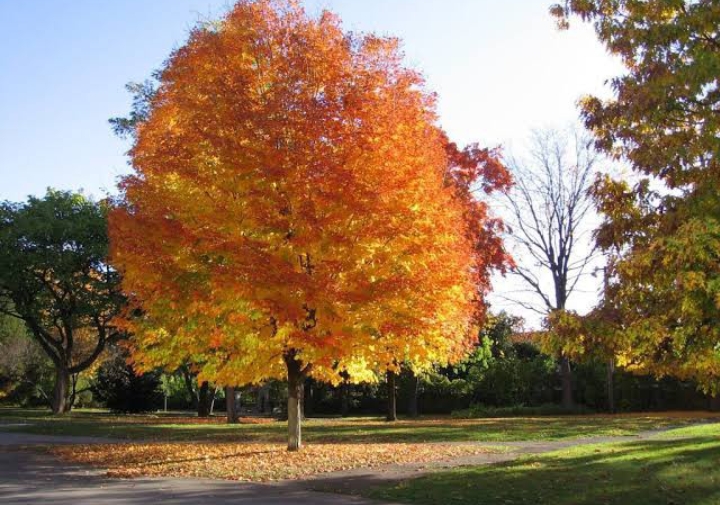
- Scientific Name: Acer glabrum
- Size: 15 to 25 feet tall
- Fall color: Yellow, red and orange
- Native Area: United States
Acer glabrum is native to western North America, commonly found in the Rocky Mountains of the United States and Canada, ranging from southeastern Alaska, British Columbia and western Alberta, east to western Nebraska.
This tree often grows between 15 and 25 feet tall. Though it may have a single dominant stem, this maple most often occurs as a multi-stemmed shrub. The tree produces small yellow-green flowers that bloom in early spring before the leaves appear.
The leaves are green in color, turning yellow or red in the fall. The bark of the tree is grayish-brown in color and has a rough texture. The wood is hard and close-grained, and can be used for furniture, and other wood products.